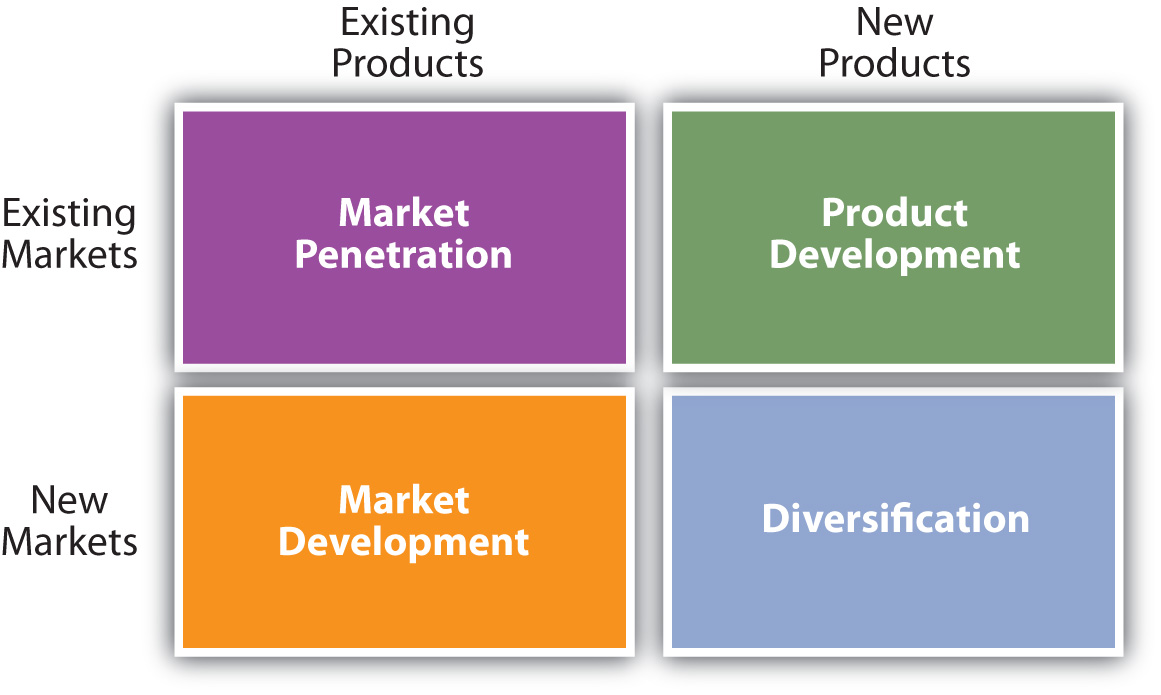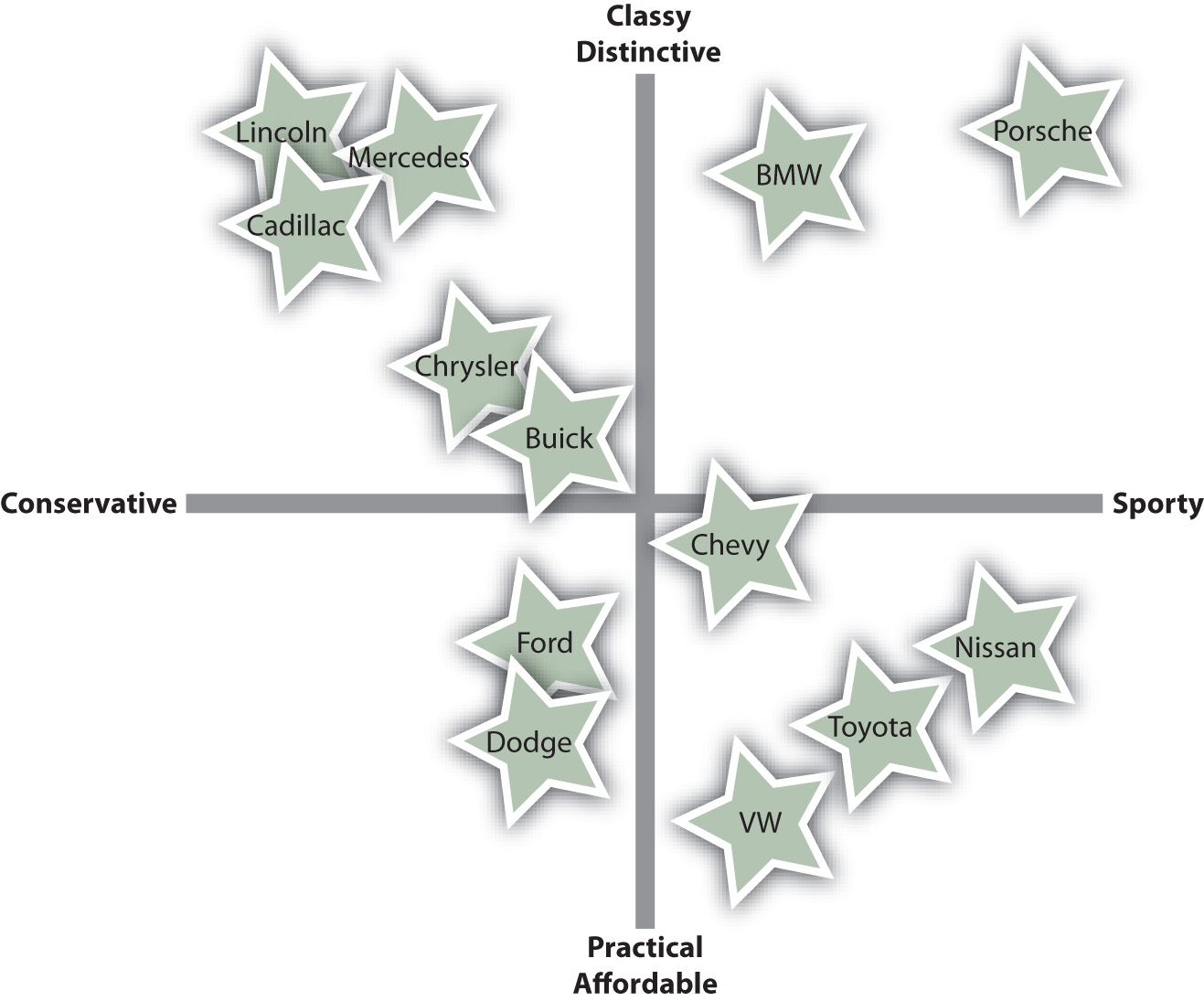10.4 Step 2: Market-Product Focus & Goal Setting
Objectives are what organizations want to accomplish—the end results they want to achieve—in a given time frame. In addition to being accomplished within a certain time frame, objectives should be realistic (achievable) and be measurable, if possible. “To increase sales by 2 percent by the end of the year” is an example of an objective an organization might develop. You have probably set objectives for yourself that you want to achieve in a given time frame. For example, your objectives might be to maintain a certain grade point average and get work experience or an internship before you graduate.
The completed SWOT analysis (Step 1), informs the organization’s marketing objectives. Given the strengths, weaknesses, opportunities, and threats, companies can determine indicated actions by leveraging their strengths, shoring up their weaknesses, capitalizing on opportunities, and turning threats to their advantage.
A firm’s marketing objectives should be consistent with the company’s objectives at other levels, such as the corporate level and business level. An example of a marketing objective for PepsiCo might be “to increase by 4 percent the market share of Gatorade by the end of the year.”
The marketing objective helps the firm allocate resources and divvy up the tasks that employees need to do for the company to meet its goals. A great tool to start goal-setting for the organization is shown in Figure 10.9: “Ansoff Matrix”. Based on the SWOT analysis, marketing teams can determine their go-to-market strategies by using this tool.
Market penetration strategies focus on increasing a firm’s sales of its existing products or services to its existing customers. Companies often offer consumers special promotions or low prices to increase their usage and encourage them to buy products. When Frito-Lay distributes money-saving coupons to customers or offers them discounts to buy multiple packages of snacks, the company is utilizing a penetration strategy. The Campbell Soup Company gets consumers to buy more soup by providing easy recipes using their soup as an ingredient for cooking quick meals.
Product and service development strategies involve creating new products/services for existing customers. A new product or service can be a totally new innovation, an improved product/service, or a product/service with enhanced value, such as one with a new feature. Cell phones that allow consumers to charge purchases with the phone or take pictures are examples of a product with enhanced value. A new product/service can also be one that comes in different variations, such as new flavours, colours, and sizes. Mountain Dew Voltage, introduced by PepsiCo Americas Beverages in 2009, is an example. Keep in mind, however, that what works for one company might not work for another. For example, just after Starbucks announced it was cutting back on the number of its lunch offerings, Dunkin’ Donuts announced it was adding items to its lunch menu.
Market development strategies focus on entering new markets with existing products/services. For example, during the recent economic downturn, manufacturers of high-end coffee makers began targeting customers who go to coffee shops. The manufacturers are hoping to develop the market for their products by making sure consumers know they can brew a great cup of coffee at home for a fraction of what they spend at Starbucks.
New markets can include any new groups of customers such as different age groups, new geographic areas, or international markets. Many companies, including PepsiCo and Hyundai, have entered—and been successful in—rapidly emerging markets such as Russia, China, and India. Decisions to enter foreign markets are based on a company’s resources as well as the complexity of factors such as the political environment, economic conditions, competition, customer knowledge, and probability of success in the desired market. As Figure 10.9: “Ansoff Matrix” shows, there are different ways, or strategies, by which firms can enter international markets. The strategies vary in the amount of risk, control, and investment that firms face. Firms can simply export, or sell their products/services to buyers abroad, which is the least risky and least expensive method but also offers the least amount of control. Many small firms export their products/services to foreign markets.
After the marketing goal is set, using the Ansoff Matrix (Fig 10.9 ), companies should segment the market, select their target audience, and position the product/service in the minds of their selected target audience. This will ensure that the marketing mix (Step 3) achieves the marketing goals set by the organization.
Selecting Market Segments
Henry Ford proved that mass marketing can work—at least for a while. Mass marketing is also efficient because you don’t have to tailor any part of the offering for different groups of consumers, which is more work and costs more money. The problem is that buyers are not all alike. If a competitor comes along and offers these groups a product/service (or products/services) that better meet their needs, you will lose business.
Multisegment Marketing
Most firms tailor their offerings in one way or another to meet the needs of different segments of customers. Because these organizations don’t have all their eggs in one basket, they are less vulnerable to competition. Marriott International is an example of a company that operates in multiple market segments. The company has different types of facilities designed to meet the needs of different market segments. Marriott has invested in unique brands so consumers don’t confuse the brand and the brand is not diluted. Some of the Marriott brands and their target markets are as follows:
- Marriott Courtyard. Targeted at over-the-road travellers.
- Ritz-Carlton Hotels. Targeted at luxury travellers.
- Marriott Conference Centers. Targeted at businesses hosting small- and mid-sized meetings.
- Marriott ExecuStay. Targeted at executives needing month-long accommodations.
- Marriott Vacation Clubs. Targeted at travellers seeking to buy timeshares.
A multisegment marketing strategy can allow firms to respond to demographic changes and other trends in markets. For example, the growing number of people too old to travel have the option of moving into one of Marriott’s “Senior Living Services” facilities, which cater to retirees who need certain types of care. A multisegment strategy can also help companies weather an economic downturn by allowing customers to trade up or down among brands and products/services. Suppose you take a pay cut and can’t afford to stay at Marriott’s Ritz-Carlton hotels anymore. A room at a JW Marriott—the most luxurious of the Marriott-brand hotels but cheaper than the Ritz—is available to you. A multisegment strategy can also help companies deal with the product/service life cycle issues. If one brand or product/service is “dying out,” the company has others to compete with.
Concentrated Marketing
Some firms—especially smaller ones with limited resources—engage in concentrated marketing. Concentrated marketing involves targeting a very select group of customers. Concentrated marketing can be a risky strategy because companies really do have all their eggs in one basket. The auto parts industry is an example. Traditionally, many North American auto parts makers have supplied parts exclusively to auto manufacturers. But when General Motors, Ford, Chrysler, and other auto companies experienced a slump in sales following the recession that began in 2008, the auto parts makers found themselves in trouble. Many of them began trying to make and sell parts for wind turbines, aerospace tools, solar panels, and construction equipment (Simon, 2009).
Niche marketing involves targeting an even more select group of consumers. When engaging in niche marketing, a company’s goal is to be a big fish in a small pond instead of a small fish in a big pond1. Some examples of companies operating in niche markets include those shown in Table 10.1: “Companies That Operate In Niche Markets”
| Company | Niche | Market Share (%) |
|---|---|---|
| Hohner | Harmonicas | 85 |
| Tetra | Tropical fish food | 80 |
| Swarovski | Crystal jewels | 65 |
| Uwatec | Snorkelling equipment | 60 |
| St. Jude Medical Center | Artificial heart valves | 60 |
Source: José María Manzanedo, “Market Segmentation Strategies. How to Maximize Opportunities on the Potential Market,” February 20, 2005, (accessed December 1, 2009).
Micro-targeting, or narrowcasting, is a new effort to isolate markets and target them. It was originally used to segment voters during elections, including the 2008 U.S. presidential election. Micro-targeting involves gathering all kinds of data available on people—everything from their tax and phone records to the catalogues they receive. One company that compiles information such as this is Acxiom. For a fee, Acxiom can provide you with a list of Hispanic consumers who own two pets, have caller ID, drive a sedan, buy certain personal care products, subscribe to certain television cable channels, read specified magazines, and have income and education levels within a given range (Schiffman & Kanuk, 2010). Clearly, microtargeting has ethical implications and privacy issues.
Selecting Target Markets
After you segment buyers and develop a measure of consumer insight about them, you can begin to see those that have more potential. Now you are hunting with a rifle instead of a shotgun. The question is, do you want to spend all day hunting squirrels or ten-point bucks? An attractive market has the following characteristics:
- It is sizeable (large) enough to be profitable given your operating cost. Only a tiny fraction of the consumers in China can afford to buy cars. However, because the country’s population is so large (nearly 1.5 billion people), more cars are sold in China than in Europe (and in the United States, depending on the month). In 2008, three billion people in the world were owners of cell phones. But that still left three billion who were not (Corbett).
- It is growing. The middle class of India is growing rapidly, making it a very attractive market for consumer products companies. People under thirty make up the majority of the Indian population, fueling the demand for “Bollywood” (Indian-made) films.
- It is not already swamped by competitors, or you have found a way to stand out in a crowd. IBM used to make PCs. However, after the marketplace became crowded with competitors, IBM sold the product line to a Chinese company called Lenovo.
- Either it is accessible or you can find a way to reach it. Accessibility, or the lack of it, could include geographic accessibility, political and legal barriers, technological barriers, or social barriers. For example, to overcome geographic barriers, the consumer products company Unilever hires women in third-world countries to distribute the company’s products to rural consumers who lack access to stores.
- The company has the resources to compete in it. You might have a great idea to compete in the wind-power market. However, it is a business that is capital intensive. What this means is that you will either need a lot of money or must be able to raise it. You might also have to compete with the likes of T. Boone Pickens, an oil tycoon who is attempting to develop and profit from the wind-power market. Does your organization have the resources to do this?
- It “fits in” with your firm’s mission and objectives. Consider TerraCycle, which has made its mark by selling organic products in recycled packages. Fertilizer made from worm excrement and sold in discarded plastic beverage bottles is just one of its products. It wouldn’t be a good idea for TerraCycle to open up a polluting, coal-fired power plant, no matter how profitable the market for the service might be.
Positioning & Repositioning
Why should buyers purchase your offering versus another? If your product/service faces competition, you will need to think about how to “position” it in the marketplace relative to competing products and services. After all, you don’t want the product to be just another “face in the crowd” in the minds of consumers. Positioning is how consumers perceive a product/service relative to the competition. Companies want to have a distinctive image and offering that stands out from the competition in the minds of consumers.
One way to position your product/service is to plot customer survey data on a perceptual map. A perceptual map is a two-dimensional graph that visually shows where your product/service stands, or should stand, relative to your competitors, based on criteria important to buyers. The criteria can involve any number of characteristics—price, quality, level of customer service associated with the product/service, and so on. An example of a perceptual map is shown in Figure 10.10: “Product/Service Positioning Map”. To avoid head-to-head competition with your competitors, you want to position your product/service somewhere on the map where your competitors aren’t clustered.
Many companies use taglines in their advertising to try to position their products/services in the minds of the buyer—where they want them, of course. A tagline is a catchphrase designed to sum up the essence of a product/service. You perhaps have heard Wendy’s tagline “It’s better than fast food.” The tagline is designed to set Wendy’s apart from restaurants like McDonald’s and Burger King—to plant the idea in consumers’ heads that Wendy’s offerings are less “fast foodish,” given the bad rap fast food gets these days.
Sometimes firms find it advantageous to reposition their products or services—especially if they want the product/service to begin appealing to different market segments. Repositioning is an effort to “move” a product or service to a different place in the minds of consumers. The i-house, a prefab house built by Clayton Homes, a mobile home manufacturer, is an example. According to the magazine Popular Mechanics, the i-house “looks like a house you’d order from IKEA, sounds like something designed by Apple, and consists of amenities—solar panels, tankless water heaters and rainwater collectors—that one would expect to come from an offbeat green company out of California selling to a high-end market” (Schwartz, 2009). A Clayton Homes spokesperson says, “Are we repositioning to go after a new market? I would think we are maintaining our value to our existing market and expanding the market to include other buyers that previously wouldn’t have considered our housing product1.”
In 2009, Porsche unveiled its new line of Panamera vehicles at a Shanghai car show. The car is a global model, but unlike Porsche’s other cars, it’s longer. Why? Because rich car buyers in China prefer to be driven by chauffeurs (Gapper, 2009). How do you think Porsche was trying to reposition itself for the future?




